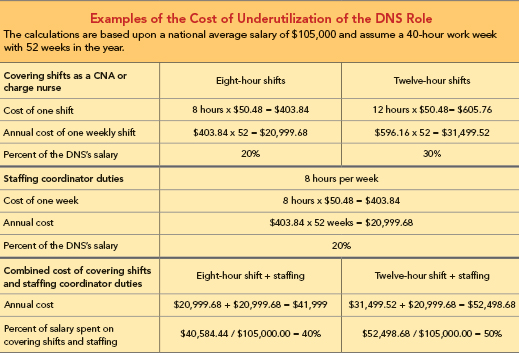Maximize the DNS’s Role to Succeed in Value-Based Care
Alexis Roam, RN-BC
11/1/2022
 The director of nursing services (DNS) plays a pivotal role in the success of a skilled nursing facility (SNF). As the leader of clinical care and services, the DNS drives the public ratings and overall performance of the quality of nursing care of a SNF, which impact census. Referral sources, including hospitals, form partnerships with SNFs based on this performance. Moreover, people base their selection of which SNF they will patronize based upon public ratings and the partnerships with hospitals. In addition, most of the regulatory and legal risks assumed by the SNF are related to nursing care. With so much at stake already, and with health care shifting to a value-based care system, the quality of nursing care and the significance of the DNS’s role in leading it are more important than ever.
The director of nursing services (DNS) plays a pivotal role in the success of a skilled nursing facility (SNF). As the leader of clinical care and services, the DNS drives the public ratings and overall performance of the quality of nursing care of a SNF, which impact census. Referral sources, including hospitals, form partnerships with SNFs based on this performance. Moreover, people base their selection of which SNF they will patronize based upon public ratings and the partnerships with hospitals. In addition, most of the regulatory and legal risks assumed by the SNF are related to nursing care. With so much at stake already, and with health care shifting to a value-based care system, the quality of nursing care and the significance of the DNS’s role in leading it are more important than ever.
Expectation of a DNS
The DNS is often chosen because they possess in-depth knowledge of the normal changes of aging and can care for elders as they navigate the relationship between wellness and aging, proving they excel as a gerontological registered nurse (RN). This is demonstrated by their ability to promote the elder’s strengths to foster wellness while simultaneously addressing the elder’s needs as age advances and/or disease and illness are experienced. The expectation is the DNS will replicate the same level of excellence they provided individually throughout the nursing department by leading the development and implementation of systems of nursing care that consistently produce desired outcomes. However, fulfillment of this expectation is not achieved when the DNS is underutilized in their main role.
 Underutilization of a DNS
Underutilization of a DNS
A DNS is underutilized when they are expected to assume responsibility for a job that does not require their expertise and can be completed by someone else. For example, the staffing coordinator position is vital to the operations of the SNF, but it does not require the skills of a DNS. Underutilization also occurs when the DNS is included in the staffing float pool and consistently fills open shifts as a certified nurse aide (CNA) or charge nurse. Although each of these roles is essential, they do not require the skills of the DNS and take away from the DNS’s time to effectively provide clinical leadership.
Despite the DNS’s best attempts to juggle the expectations as the leader of clinical care and services as well as the other responsibilities outside the scope of the DNS, the workload overwhelms them. At this point, the DNS makes a choice—they quit because success as the leader of clinical care and services can’t be achieved or stay but prioritize the non-DNS responsibilities over the DNS responsibilities.
A SNF will go to great lengths to secure an RN with the talents and skills to be the DNS, including offering an appealing benefits and compensation package; however, the contradiction of hiring a DNS, but then not fully utilizing them in that capacity becomes apparent when considering the return on investment. The table, to the right, shows two examples of the breakdown in salary of a SNF paying a DNS to spend between 40 and 50 percent of their time engaged in non-DNS tasks. The decision to underutilize a DNS in their main role greatly diminishes the productivity of the one person hired to complete DNS tasks; thus, the investment in the DNS has a poor return.
Maximize the DNS Role
The health care system is transforming to value-based care, and this means SNFs must be innovative in the methods used to consistently produce quality of care and life outcomes as efficiently as possible. While the staffing crisis and other challenges resulting from the pandemic have exacerbated the underutilization of DNSs, it is not a new trend. Nonetheless, this approach does not position a SNF to thrive in value-based care, because the DNS needs to be at the heart of managing clinical care and services so that the facility can produce the best outcomes in nursing care. Therefore, a paradigm shift is necessary to change perceptions and practices that maximize the DNS’s role, and also attract and retain RNs who can navigate the current turbulence and are capable of leading a nursing department that can thrive in value-based care.
Recognize the DNS as a Leader
Although it sounds simplistic, the first action management can take is to redefine what a DNS means to the SNF in a way that recognizes the significance of the role as the leader of clinical care and services, rather than just an RN who fulfills a regulatory requirement with a title. Areas the DNS should lead that enable success in value-based care include the implementation of evidence-based practice, development of other gerontological nurses and CNAs, collaboration with hospitals and other health care settings, fiscal and budgetary input and management, and the design of efficient systems that can consistently produce quality and maintain regulatory compliance.

Establish Expectations and Goals
Expectations provide clarity as to what the DNS role entails and the operating guidelines to execute functions of the position. Expectations also hold management accountable to commit to the expectations they set forth for a DNS. Management will need to formulate a strategy that includes measurable goals and concrete action steps to transition from the old expectations to the new expectations. For example, if the DNS is covering shifts, a plan to stabilize staff is imperative. Goals encourage the DNS to be part of the strategy and communicate what the priorities are. This empowers the DNS to overcome the current tumult but also inspires the pursuit of high performance in the nursing department, including the critical need to recruit and retain staff.
Underutilization of the DNS is not new, but SNFs that want to thrive in value-based care must change this practice. Maximize the DNS role by valuing the significance of clinical leadership and the potential the DNS has to impact the success of the SNF.
Alexis Roam, MSN, RN-BC, DNS-CT, QCP, is a curriculum development specialist for the American Association of Post-Acute Care Nursing (AAPACN). Roam can be reached at aroam@aapacn.org.

Learn more: